Brother DCP-6690CW User Manual
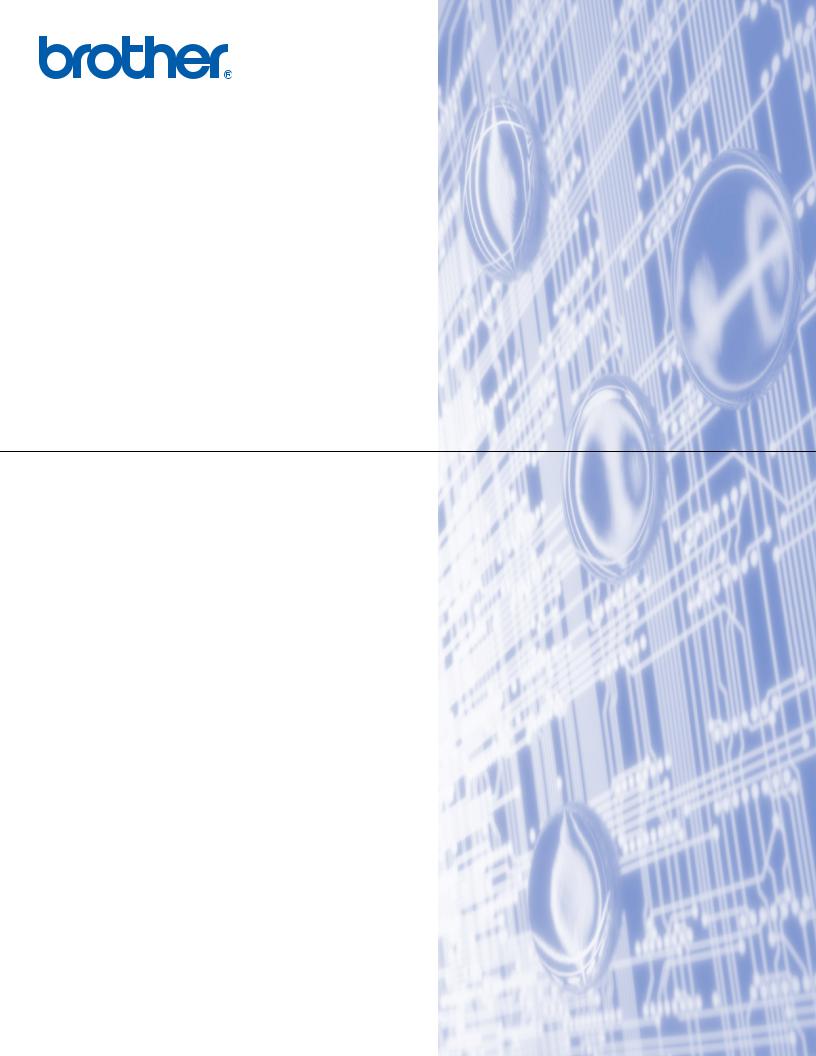
Multi-Protocol On-board Ethernet Multi-function Print Server and Wireless (IEEE 802.11b/g) Ethernet Multi-function Print Server
NETWORK
USER’S GUIDE
Please read this manual thoroughly before using this machine on your network. You can print or view this manual from the CD-ROM at any time, please keep the CD-ROM in a convenient place for quick and easy reference at all times.
The Brother Solutions Center (http://solutions.brother.com) is your one stop resource for all your printing needs. Download the latest drivers and utilities for your machine, read FAQs and troubleshooting tips or learn about special printing solutions.
Version A
ENG
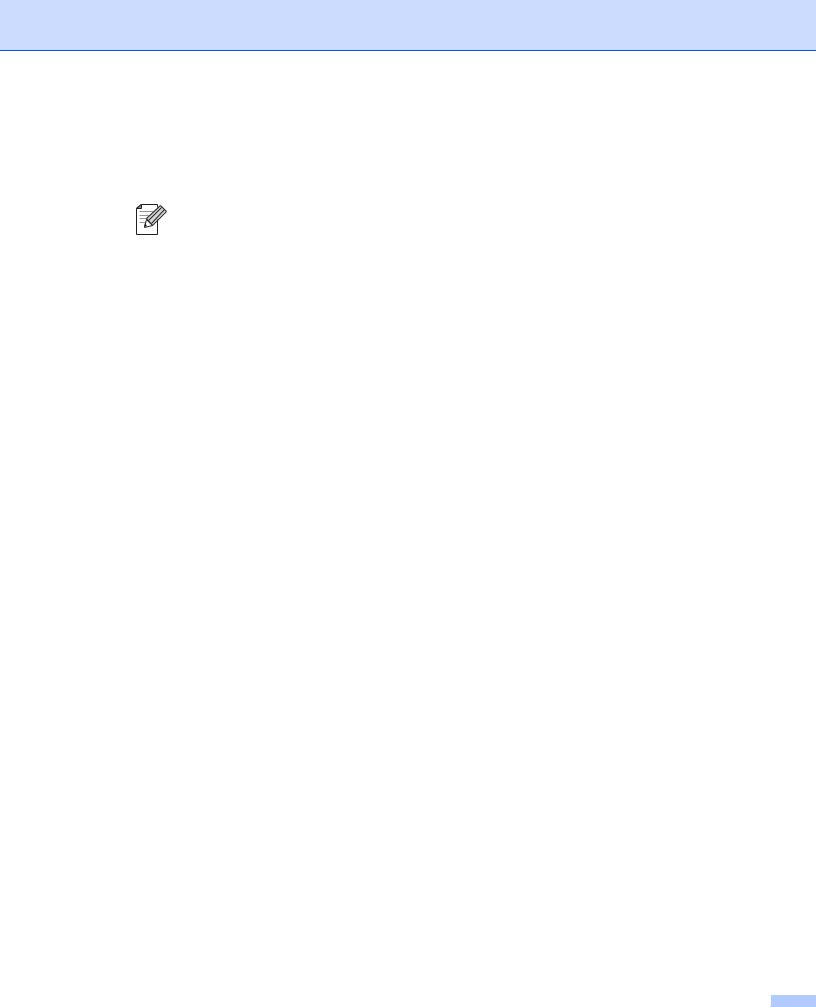
Definitions of warnings, cautions, and notes
We use the following icon throughout this User’s Guide:
Notes tell you how you should respond to a situation that may arise or give tips about how the operation works with other features.
Trademarks
Brother and the Brother logo are registered trademarks and BRAdmin Professional is a trademark of Brother Industries, Ltd.
UNIX is a registered trademark of The Open Group.
Linux® is the registered trademark of Linus Torvalds in the U.S. and other countries. Apple and Macintosh are registered trademarks of Apple Inc.
Windows Vista is either a registered trademark or a trademark of Microsoft Corporation in the United States and other countries.
Microsoft and Windows are registered trademarks of Microsoft Corporation in the United States and/or other countries.
BROADCOM, SecureEasySetup and the SecureEasySetup logo are trademarks or registered trademarks of Broadcom Corporation in the United States and/or other countries.
AOSS is a trademark of Buffalo Inc.
Wi-Fi, WPA and WPA2 are registered trademarks and Wi-Fi Protected Setup is a trademark of the Wi-Fi Alliance.
All other terms, brand and product names mentioned in this User’s Guide are registered trademarks or trademarks of their respective companies.
Copyright and License
Part of the software embedded in this product is gSOAP software.
Portions created by gSOAP are Copyright (C) 2001–2004 Robert A. van Engelen, Genivia inc. All Rights Reserved.
THE SOFTWARE IN THIS PRODUCT WAS IN PART PROVIDED BY GENIVIA INC AND ANY EXPRESS OR IMPLIED WARRANTIES, INCLUDING, BUT NOT LIMITED TO, THE IMPLIED WARRANTIES OF MERCHANTABILITY AND FITNESS FOR A PARTICULAR PURPOSE ARE DISCLAIMED. IN NO EVENT SHALL THE AUTHOR BE LIABLE FOR ANY DIRECT, INDIRECT, INCIDENTAL, SPECIAL, EXEMPLARY, OR CONSEQUENTIAL DAMAGES (INCLUDING, BUT NOT LIMITED TO, PROCUREMENT OF SUBSTITUTE GOODS OR SERVICES; LOSS OF USE, DATA, OR PROFITS; OR BUSINESS INTERRUPTION) HOWEVER CAUSED AND ON ANY THEORY OF LIABILITY, WHETHER IN CONTRACT, STRICT LIABILITY, OR TORT (INCLUDING NEGLIGENCE OR OTHERWISE) ARISING IN ANYWAY OUT OF THE USE OF THIS SOFTWARE, EVEN IF ADVISED OF THE POSSIBILITY OF SUCH DAMAGE.
i

Compilation and publication notice
Under the supervision of Brother Industries, Ltd., this manual has been compiled and published, covering the latest product’s descriptions and specifications.
The contents of this manual and the specifications of this product are subject to change without notice.
Brother reserves the right to make changes without notice in the specifications and materials contained herein and shall not be responsible for any damages (including consequential) caused by reliance on the materials presented, including but not limited to typographical and other errors relating to the publication.
©2008 Brother Industries, Ltd.
IMPORTANT NOTE
This product is approved for use in the country of purchase only. Do not use this product outside the country of purchase as it may violate the wireless telecommunication and power regulations of that country.
Windows® XP in this document represents Windows® XP Professional, Windows® XP Professional x64 Edition and Windows® XP Home Edition.
ii

Brother numbers
IMPORTANT
For technical and operational assistance, you must call the country where you purchased the machine. Calls must be made from within that country.
For Customer Service
In USA |
1-877-BROTHER (1-877-276-8437) |
|
1-901-379-1215 (FAX) |
In Canada |
1-877-BROTHER |
|
514-685-4898 (FAX) |
In Europe |
Visit http://www.brother.com for contact information on your local Brother office. |
Service center locator (USA)
For the location of a Brother authorized service center, call 1-877-BROTHER (1-877-276-8437).
Service center locations (Canada)
For the location of a Brother authorized service center, call 1-877-BROTHER.
If you have any comments or suggestions, please write to us at:
In USA |
Customer Support |
|
Brother International Corporation |
|
100 Somerset Corporate Boulevard |
|
Bridgewater NJ 08807-0911 |
|
|
In Canada |
Brother International Corporation (Canada), Ltd. |
|
- Marketing Dept. |
|
1, rue Hôtel de Ville |
|
Dollard-des-Ormeaux, PQ, Canada H9B 3H6 |
|
|
In Europe |
European Product & Service Support |
|
1 Tame Street |
|
Audenshaw |
|
Manchester, M34 5JE, UK |
|
|
Internet address
Brother Global Web Site: http://www.brother.com
For Frequently Asked Questions (FAQs), Product Support, Driver Updates and Utilities: http://solutions.brother.com
iii
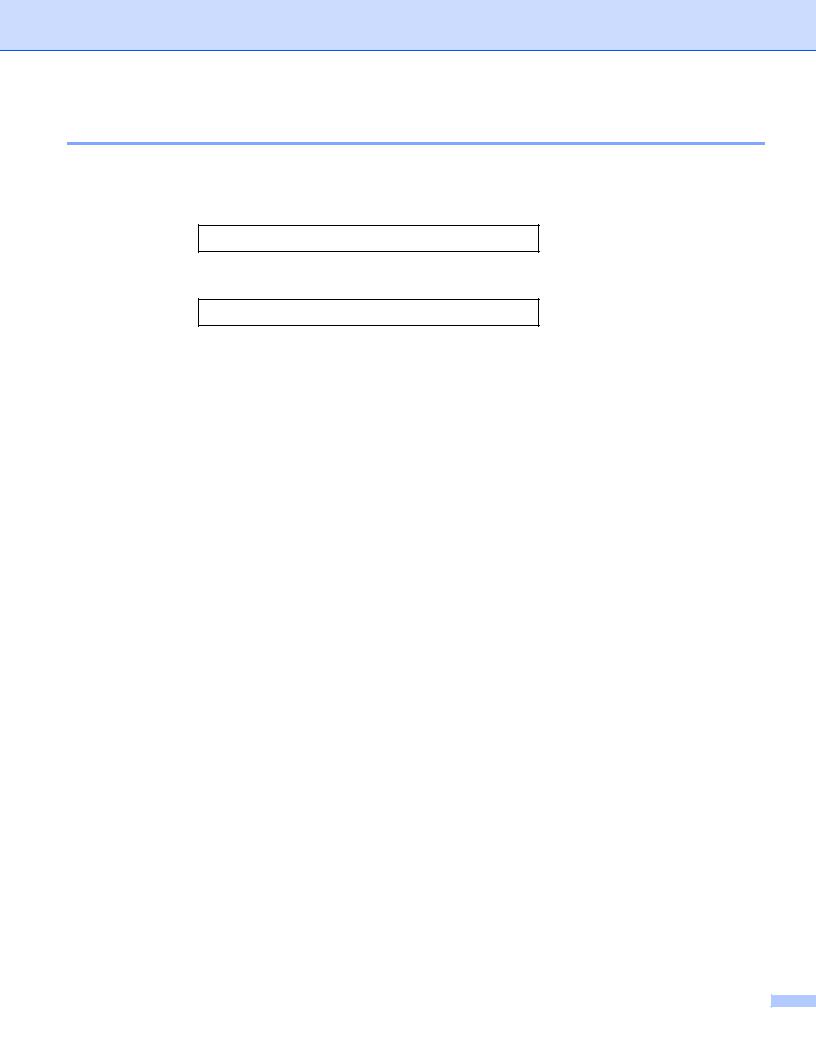
Ordering accessories and supplies
In USA: 1-877-552-MALL (1-877-552-6255)
1-800-947-1445 (fax)
http://www.brothermall.com
In Canada: |
1-877-BROTHER |
http://www.brother.ca
iv

Table of Contents |
|
|
1 |
Introduction |
1 |
|
Overview.................................................................................................................................................... |
1 |
|
Network features........................................................................................................................................ |
2 |
|
Network printing................................................................................................................................... |
2 |
|
Network scanning ................................................................................................................................ |
2 |
|
Network PC-FAX (Not available for DCP models)............................................................................... |
2 |
|
Network PhotoCapture Center™......................................................................................................... |
2 |
|
Management utilities............................................................................................................................ |
3 |
|
Internet Fax/Scan to E-mail Server (MFC-6490CW: standard, MFC-5890CN: available as a |
|
|
download)........................................................................................................................................ |
3 |
|
Types of Network Connections.................................................................................................................. |
4 |
|
Wired network connection example..................................................................................................... |
4 |
|
Wireless network connection examples .............................................................................................. |
6 |
|
Protocols.................................................................................................................................................... |
7 |
|
TCP/IP protocols and functions ........................................................................................................... |
7 |
|
Other Protocol ..................................................................................................................................... |
8 |
2 |
Configuring your machine for a network with an Ethernet cable connection |
9 |
|
Overview.................................................................................................................................................... |
9 |
|
IP addresses, subnet masks and gateways .............................................................................................. |
9 |
|
IP address ........................................................................................................................................... |
9 |
|
Subnet mask...................................................................................................................................... |
10 |
|
Gateway (and router)......................................................................................................................... |
10 |
|
Step by step chart.................................................................................................................................... |
11 |
|
Setting up the IP address and subnet mask............................................................................................ |
12 |
|
Using the BRAdmin Light utility to configure your machine as a network printer .............................. |
12 |
|
Using the control panel to configure your machine for a network...................................................... |
14 |
|
Using other methods to configure your machine for a network ......................................................... |
14 |
|
Changing the print server settings........................................................................................................... |
15 |
|
Using the BRAdmin Light utility to change the print server settings .................................................. |
15 |
|
Using the BRAdmin Professional utility to change the wireless settings (For Windows®)................. |
16 |
|
Using the Remote Setup to change the print server settings (Not available for DCP models).......... |
17 |
|
Using the control panel to change the print server settings............................................................... |
17 |
v

3 |
Configuring your machine for a wireless network |
|
|
(Not available for MFC-5490CN and MFC-5890CN) |
18 |
|
Overview.................................................................................................................................................. |
18 |
|
Wireless network terms and concepts ..................................................................................................... |
19 |
|
SSID (Service Set Identifier) and channels ....................................................................................... |
19 |
|
Authentication and encryption ........................................................................................................... |
19 |
|
Step by step chart for wireless network configuration ............................................................................ |
21 |
|
For Infrastructure mode ..................................................................................................................... |
21 |
|
For Ad-hoc mode............................................................................................................................... |
22 |
|
Confirm your network environment.......................................................................................................... |
23 |
|
Connected to a computer with an access point in the network (Infrastructure mode)....................... |
23 |
|
Connected to a wireless capable computer without an access point in the network |
|
|
(Ad-hoc mode)............................................................................................................................... |
23 |
|
Confirm your wireless network setup method.......................................................................................... |
24 |
|
Configuration using the machine’s control panel Setup Wizard to configure your wireless |
|
|
network machine ........................................................................................................................... |
24 |
|
Configuration using the SES/WPS/AOSS control panel menu (Infrastructure mode only) ............... |
24 |
|
Configuration using the PIN Method of Wi-Fi Protected Setup™ (Infrastructure mode only)............ |
25 |
|
Configuration using the Brother installer application on the CD-ROM to configure your wireless |
|
|
network machine ........................................................................................................................... |
26 |
|
Configuring your machine for a wireless network.................................................................................... |
27 |
|
Using the Setup Wizard from the control panel ................................................................................. |
27 |
|
Using the SES/WPS/AOSS control panel menu to configure your machine for a |
|
|
wireless network............................................................................................................................ |
31 |
|
Using the PIN Method of Wi-Fi Protected Setup™............................................................................ |
35 |
|
Using the Brother automatic installer application on the CD-ROM to configure your machine for a |
|
|
wireless network............................................................................................................................ |
37 |
4 |
Wireless configuration for Windows® using the Brother installer application |
|
|
(Not available for MFC-5490CN and MFC-5890CN) |
38 |
|
Configuration in Infrastructure mode ....................................................................................................... |
38 |
|
Before configuring the wireless settings ............................................................................................ |
38 |
|
Configure the wireless settings.......................................................................................................... |
39 |
|
Configuration using the SES/WPS/AOSS control panel menu (One-Push method) ............................... |
45 |
|
Before configuring the wireless settings ............................................................................................ |
45 |
|
Configure the wireless settings.......................................................................................................... |
45 |
|
Configuration in Ad-hoc Mode ................................................................................................................. |
50 |
|
Before configuring the wireless settings ............................................................................................ |
50 |
|
Configure the wireless settings.......................................................................................................... |
50 |
vi

5 |
Wireless Configuration for Macintosh® using the Brother installer application |
|
|
(Not available for MFC-5490CN and MFC-5890CN) |
58 |
|
Configuration in Infrastructure mode ....................................................................................................... |
58 |
|
Before configuring the wireless settings ............................................................................................ |
58 |
|
Configure the wireless settings.......................................................................................................... |
59 |
|
Configuration using the SES/WPS/AOSS control panel menu (One-Push method) ............................... |
65 |
|
Before configuring the wireless settings ............................................................................................ |
65 |
|
Configure the wireless settings.......................................................................................................... |
65 |
|
Configuration in Ad-hoc Mode ................................................................................................................. |
69 |
|
Before configuring the wireless settings ............................................................................................ |
69 |
|
Configure the wireless settings.......................................................................................................... |
69 |
6 |
Control panel setup |
77 |
|
Network menu.......................................................................................................................................... |
77 |
|
TCP/IP............................................................................................................................................... |
77 |
|
Setup Misc. (MFC-5490CN only)....................................................................................................... |
90 |
|
Setup Wizard (wireless network only) ............................................................................................... |
90 |
|
SES/WPS/AOSS (wireless network only).......................................................................................... |
90 |
|
WPS w/PIN code (wireless network only) ......................................................................................... |
90 |
|
WLAN Status (wireless network only) ............................................................................................... |
91 |
|
Ethernet (wired network only)............................................................................................................ |
95 |
|
E-mail/I-FAX (For MFC-6490CW) ..................................................................................................... |
96 |
|
Scan to FTP (For MFC-5890CN and MFC-6490CW)...................................................................... |
107 |
|
Time Zone (For MFC-6490CW)....................................................................................................... |
110 |
|
Network I/F (Not available for MFC-5490CN and MFC-5890CN) ................................................... |
111 |
|
Restoring the network settings to factory default................................................................................... |
112 |
|
Printing the Network Configuration List ................................................................................................. |
113 |
7 |
Driver Deployment Wizard (Windows® only) |
114 |
|
Overview................................................................................................................................................ |
114 |
|
Connection methods.............................................................................................................................. |
114 |
|
Peer-to-Peer .................................................................................................................................... |
114 |
|
Network Shared............................................................................................................................... |
115 |
|
How to install the Driver Deployment Wizard software.......................................................................... |
115 |
|
Using the Driver Deployment Wizard software ...................................................................................... |
116 |
8 |
Network printing from Windows® basic TCP/IP Peer-to-Peer printing |
119 |
|
Overview................................................................................................................................................ |
119 |
|
Configuring the standard TCP/IP port.................................................................................................... |
120 |
|
Printer driver not yet installed .......................................................................................................... |
120 |
|
Printer driver already installed ......................................................................................................... |
120 |
|
Other sources of information ................................................................................................................. |
121 |
vii

9 |
Network printing from a Macintosh® |
122 |
|
Overview................................................................................................................................................ |
122 |
|
How to choose the print server (TCP/IP)......................................................................................... |
122 |
|
Changing the print server settings......................................................................................................... |
125 |
|
Changing the configuration using the Remote Setup (Not available for DCP models) ................... |
125 |
|
Using the BRAdmin Light utility to change the print server settings ................................................ |
125 |
|
Other sources of information ................................................................................................................. |
125 |
10 |
Internet fax and Scan to E-mail (For MFC-6490CW) |
126 |
|
Internet fax overview.............................................................................................................................. |
126 |
|
Getting connected ........................................................................................................................... |
126 |
|
Control panel key functions ............................................................................................................. |
127 |
|
Sending an Internet fax ................................................................................................................... |
128 |
|
Manually entering text ..................................................................................................................... |
128 |
|
Receiving E-mail or Internet fax ...................................................................................................... |
129 |
|
Receiving an Internet fax to your computer..................................................................................... |
129 |
|
Forwarding received E-mail and fax messages............................................................................... |
129 |
|
Relay broadcasting.......................................................................................................................... |
130 |
|
TX Verification Mail.......................................................................................................................... |
132 |
|
Setup Mail TX .................................................................................................................................. |
132 |
|
Setup Mail RX.................................................................................................................................. |
132 |
|
Error mail ......................................................................................................................................... |
132 |
|
Important information on Internet fax............................................................................................... |
133 |
|
Scan to E-mail Server overview (MFC-6490CW) .................................................................................. |
134 |
11 |
Security features (For MFC-6490CW) |
136 |
|
Overview................................................................................................................................................ |
136 |
|
Security methods for E-mail notification ................................................................................................ |
136 |
|
POP before SMTP (PbS)................................................................................................................. |
136 |
|
SMTP-AUTH (SMTP Authentication) .............................................................................................. |
136 |
|
APOP (Authenticated Post Office Protocol) .................................................................................... |
136 |
|
Using E-mail notification with user authentication ................................................................................. |
137 |
|
Managing your network machine securely using BRAdmin Professional (for Windows®) .................... |
137 |
12 |
Troubleshooting |
138 |
|
Overview................................................................................................................................................ |
138 |
|
General problems .................................................................................................................................. |
138 |
|
Network print software installation problems ......................................................................................... |
140 |
|
Printing problems................................................................................................................................... |
142 |
|
Scanning and PC Fax problems............................................................................................................ |
143 |
|
Wireless network troubleshooting.......................................................................................................... |
145 |
|
Wireless setup problems ................................................................................................................. |
145 |
|
Wireless connection problem .......................................................................................................... |
145 |
viii

A |
Appendix A |
146 |
|
Using services ....................................................................................................................................... |
146 |
|
Other ways to set the IP address (for advanced users and administrators) .......................................... |
146 |
|
Using DHCP to configure the IP address ........................................................................................ |
146 |
|
Using BOOTP to configure the IP address...................................................................................... |
147 |
|
Using RARP to configure the IP address ........................................................................................ |
148 |
|
Using APIPA to configure the IP address........................................................................................ |
148 |
|
Using ARP to configure the IP address ........................................................................................... |
149 |
|
Using the TELNET console to configure the IP address ................................................................. |
150 |
|
Installation when using a Network Print Queue or Share (printer driver only)....................................... |
151 |
|
Installation when using Web Services (For Windows Vista® users)...................................................... |
152 |
B |
Appendix B |
153 |
|
Print server specifications...................................................................................................................... |
153 |
|
Ethernet wired network.................................................................................................................... |
153 |
|
Ethernet wireless network ............................................................................................................... |
154 |
|
Function table and default factory settings ............................................................................................ |
156 |
|
Entering Text ......................................................................................................................................... |
161 |
|
For Touchscreen models ................................................................................................................ |
161 |
|
For MFC models.............................................................................................................................. |
162 |
|
For DCP models .............................................................................................................................. |
163 |
C |
Index |
164 |
ix

1 Introduction
1
Overview
The Brother machine can be shared on a 10/100 MB wired or IEEE 802.11b/802.11g wireless Ethernet network using the internal network print server. The print server supports various functions and methods of connection depending on the operating system you are running on a network supporting TCP/IP. These functions include printing, scanning, PC-FAX send, PC-FAX receive, PhotoCapture Center™, Remote Setup and Status Monitor. The following chart shows what network features and connections are supported by each operating system.
Operating Systems |
Windows® 2000 |
Mac OS® X 10.2.4 or |
|
|
Windows® XP |
greater |
|
|
|
||
|
Windows® XP |
|
|
|
Professional x64 |
|
|
|
Edition |
|
|
|
Windows Vista® |
|
|
10/100BASE-TX wired Ethernet |
r |
r |
|
(TCP/IP) |
|||
|
|
||
IEEE 802.11b/g wireless |
r |
r |
|
Ethernet (TCP/IP) 1 |
|||
|
|
||
Printing |
r |
r |
|
BRAdmin Light |
r |
r |
|
BRAdmin Professional 2 |
r |
|
|
Web BRAdmin 2 |
r |
|
|
Scanning |
r |
r |
|
|
|
|
|
PC Fax Send 3 |
r |
r |
|
PC Fax Receive 3 |
r |
|
|
Remote Setup 3 |
r |
r |
|
Status Monitor |
r |
r |
|
|
|
|
|
Driver Deployment Wizard |
r |
|
1Not available for MFC-5490CN and MFC-5890CN.
2BRAdmin Professional and Web BRAdmin are available as a download from http://solutions.brother.com.
3Not available for DCP models.
To use the Brother machine through a network, you need to configure the print server, and set up the computers you use.
1

Introduction
For Wireless Users: |
|
To achieve optimum results with normal every day document printing, place the Brother machine as close to |
1 |
the network access point (or router) as possible with minimal obstructions. Large objects and walls between the two devices as well as interference from other electronic devices can affect the data transfer speed of your documents.
Due to these factors, wireless may not be the best method of connection for all types of documents and applications. If you are printing large files, such as photos on glossy paper or multi-page documents with mixed text and large graphics, you may want to consider choosing wired Ethernet for a faster data transfer, or USB for the fastest throughput speed.
Network features
Your Brother machine has the following basic network functions.
Network printing
The print server provides printing services for Windows® 2000/XP/XP Professional x64 Edition and Windows Vista® supporting the TCP/IP protocols and Macintosh® supporting TCP/IP (Mac OS® X 10.2.4 or greater).
Network scanning
You can scan documents over the network to your computer. (See Network Scanning in the Software User’s Guide.)
Network PC-FAX (Not available for DCP models)
You can directly send a PC file as a PC-FAX over your network. (See Brother PC-FAX Software for Windows®
and Sending a Fax for Macintosh® in the Software User’s Guide for a complete description.) Windows® users can also use PC-FAX receive. (See PC-FAX receiving in the Software User’s Guide.)
Network PhotoCapture Center™
You can view, retrieve and save data from a USB flash memory drive or a media card inserted into the Brother machine.The software is automatically installed when you choose network connection during the software
installation. For Windows®, choose the PHOTOCAPTURE tab of the ControlCenter3. For more information,
see ControlCenter3 in the Software User’s Guide. For Macintosh®, launch any web browser in which FTP is available and enter FTP://xxx.xxx.xxx.xxx (where xxx.xxx.xxx.xxx is the IP address of your Brother machine). For more information, see Remote Setup & PhotoCapture Center in the Software User’s Guide.
2

Introduction
Management utilities
1
BRAdmin Light
BRAdmin Light is a utility for initial setup of network connected Brother devices. This utility can search for Brother products on your network, view the status and configure basic network settings, such as IP address.
The BRAdmin Light utility is available for Windows® 2000/XP and Windows Vista® and Mac OS® X 10.2.4 (or greater) computers. For installing BRAdmin Light on Windows®, please see the Quick Setup Guide we
provided with the machine. For Macintosh® users, BRAdmin Light will be installed automatically when you install the printer driver. If you have already installed the printer driver, you don’t have to install it again.
For more information on BRAdmin Light, visit us at http://solutions.brother.com.
BRAdmin Professional (for Windows®)
BRAdmin Professional is a utility for more advanced management of network connected Brother devices. This utility can search for Brother products on your network, view their status and configure the network
settings from a computer running Windows® system. BRAdmin Professional has additional features from BRAdmin Light.
For more information and downloading, visit us at http://solutions.brother.com.
Web BRAdmin (for Windows®)
Web BRAdmin is a utility for managing network connected Brother devices on your LAN and WAN. This utility can search for Brother products on your network, view its status and configure the network settings. Unlike
BRAdmin Professional, which is designed for Windows® only, Web BRAdmin is a server based utility that can be accessed from any client PC with a web browser that supports JRE (Java Runtime Environment). By
installing the Web BRAdmin server utility on a PC running IIS 1, connect to the Web BRAdmin server, which then communicates with the device itself.
For more information and downloading, visit us at http://solutions.brother.com.
1 Internet Information Server 4.0 or Internet Information Service 5.0/5.1/6.0/7.0
Remote Setup (Not available for DCP models)
The Remote Setup software allows you to configure network settings from a Windows® PC or Macintosh® (Mac OS® X 10.2.4 or greater) computer. (See Remote Setup in the Software User’s Guide.)
Internet Fax/Scan to E-mail Server
(MFC-6490CW: standard, MFC-5890CN: available as a download)
The Brother machine can be assigned an E-mail address allowing you to send, receive or forward documents over a Local Area Network or the Internet to PC’s or other Internet Fax machines. Before using this function, you have to configure the necessary machine settings by using the machine’s control panel. For details, see
Internet fax and Scan to E-mail (For MFC-6490CW) on page 126.
For MFC-5890CN
In order to use this function, please download the necessary software from our web site The Brother Solutions Center. (http://solutions.brother.com)
3
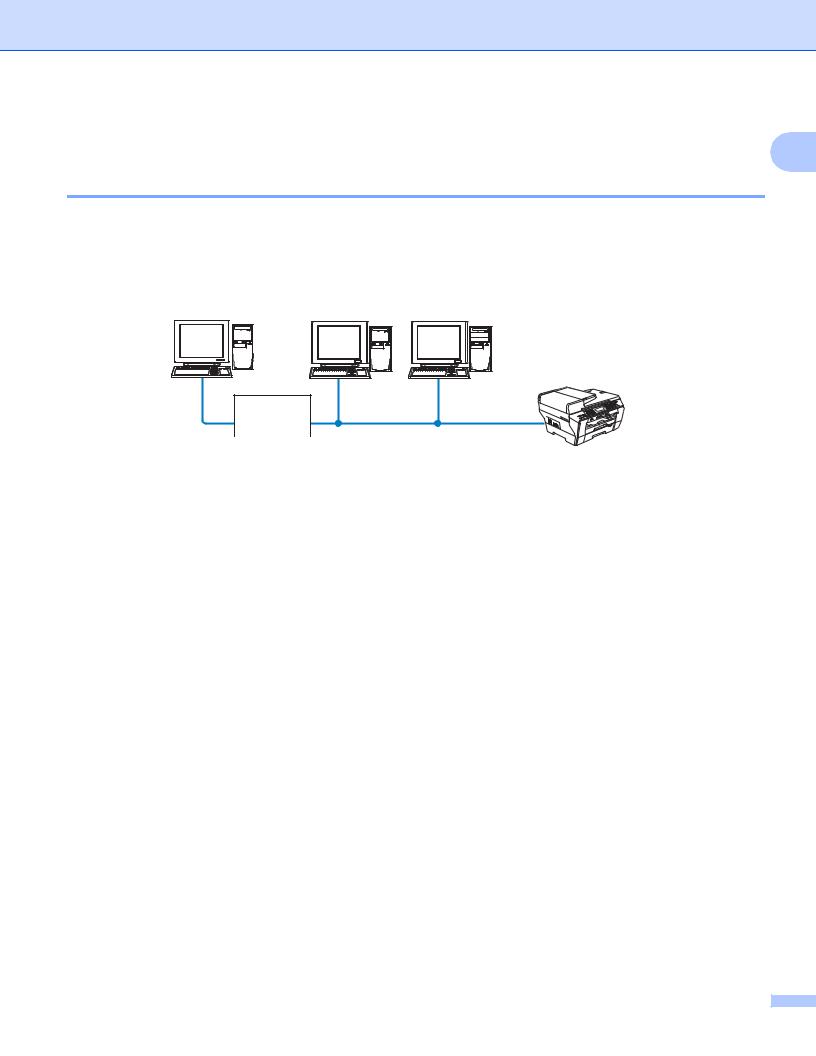
Introduction
Types of Network Connections
1
Wired network connection example
Peer-to-Peer printing using TCP/IP
In a Peer-to-Peer environment, each computer directly sends and receives data to each device. There is no central server controlling file access or printer sharing.
Windows® |
|
|
Windows® |
|
|
Windows® |
||
|
|
|
|
|
|
|
|
|
|
|
|
|
|
|
|
|
|
|
|
|
|
|
|
|
|
|
|
|
|
|
|
|
|
|
|
|
|
|
|
|
|
|
|
|
|
|
|
|
|
|
|
|
|
|
|
|
|
|
|
|
|
|
 2
2
1
TCP/IP |
|
TCP/IP |
|
1Switch or Router
2Network printer (your machine)
In a smaller network of 2 or 3 computers, we recommend the Peer-to-Peer printing method as it is easier to configure than the Network Shared Printing method. (See Network Shared Printing on page 5.)
Each computer must use the TCP/IP Protocol.
The Brother machine needs an appropriate IP address configuration.
If you are using a router, the Gateway address must be configured on the computers and the Brother machine.
4
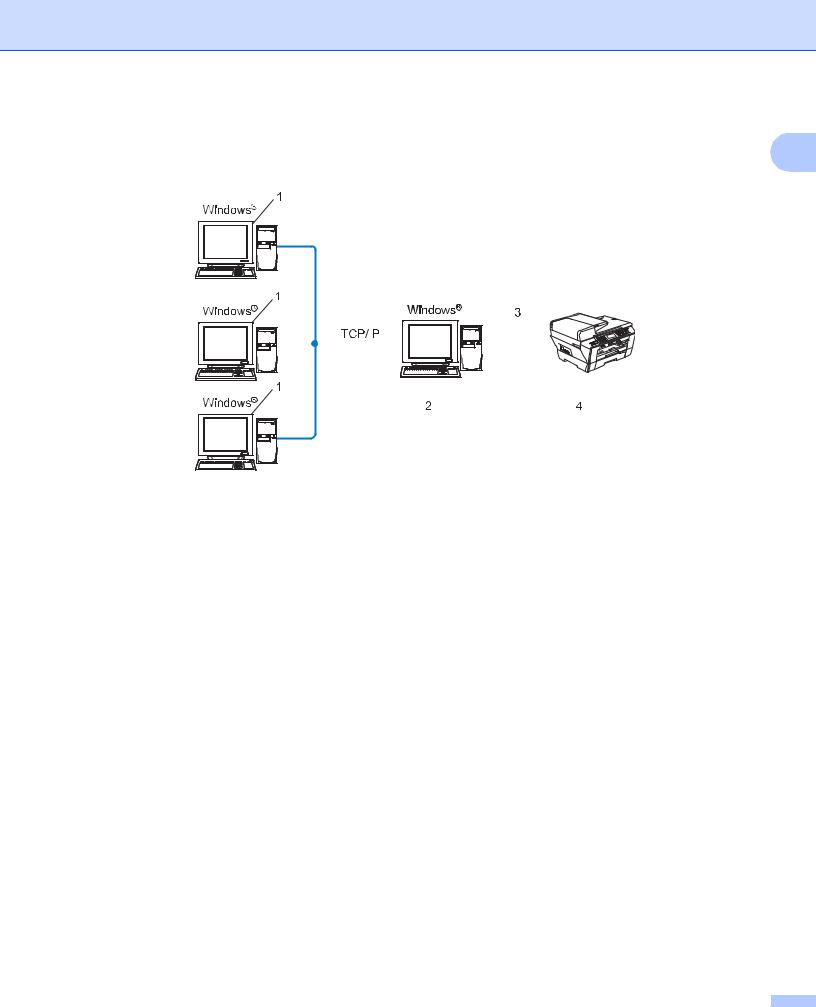
Introduction
Network Shared Printing
In a Network Shared environment, each computer sends data via a centrally controlled computer. This type |
1 |
|||||||||||||||
of computer is often called a “Server” or a “Print Server”. Its job is to control the printing of all print jobs. |
|
|||||||||||||||
|
|
|
|
|
|
|
|
|
|
|
|
|
|
|
|
|
|
|
|
|
|
|
|
|
|
|
|
|
|
|
|
|
|
|
|
|
|
|
|
|
|
|
|
|
|
|
|
|
|
|
|
|
|
|
|
|
|
|
|
|
|
|
|
|
|
|
|
|
|
|
|
|
|
|
|
|
|
|
|
|
|
|
|
|
|
|
|
|
|
|
|
|
|
|
|
|
|
|
|
|
|
|
|
|
|
|
|
|
|
|
|
|
|
|
|
|
|
|
|
|
|
|
|
|
|
|
|
|
|
|
|
|
|
|
|
|
|
|
|
|
|
|
|
|
|
|
|
|
|
|
|
|
|
|
|
|
|
|
|
|
|
|
|
|
|
|
|
|
|
|
|
|
|
|
|
|
|
|
|
|
|
|
|
|
|
|
|
|
|
|
|
|
|
|
|
|
|
|
|
|
|
|
|
|
|
|
|
|
|
|
|
|
|
|
|
|
|
|
|
|
|
|
|
|
|
|
|
|
|
|
|
|
|
|
|
|
|
|
|
|
|
|
|
|
|
|
|
|
|
|
|
|
|
|
1Client computer
2Also known as “Server” or “Print Server”
3TCP/IP or USB (where available)
4Network printer (your machine)
In a larger network, we recommend a Network Shared printing environment.
The “Server” or the “Print Server” must use the TCP/IP Print Protocol.
The Brother machine needs to have an appropriate IP address configuration unless the machine is connected via the USB interface at the server.
5
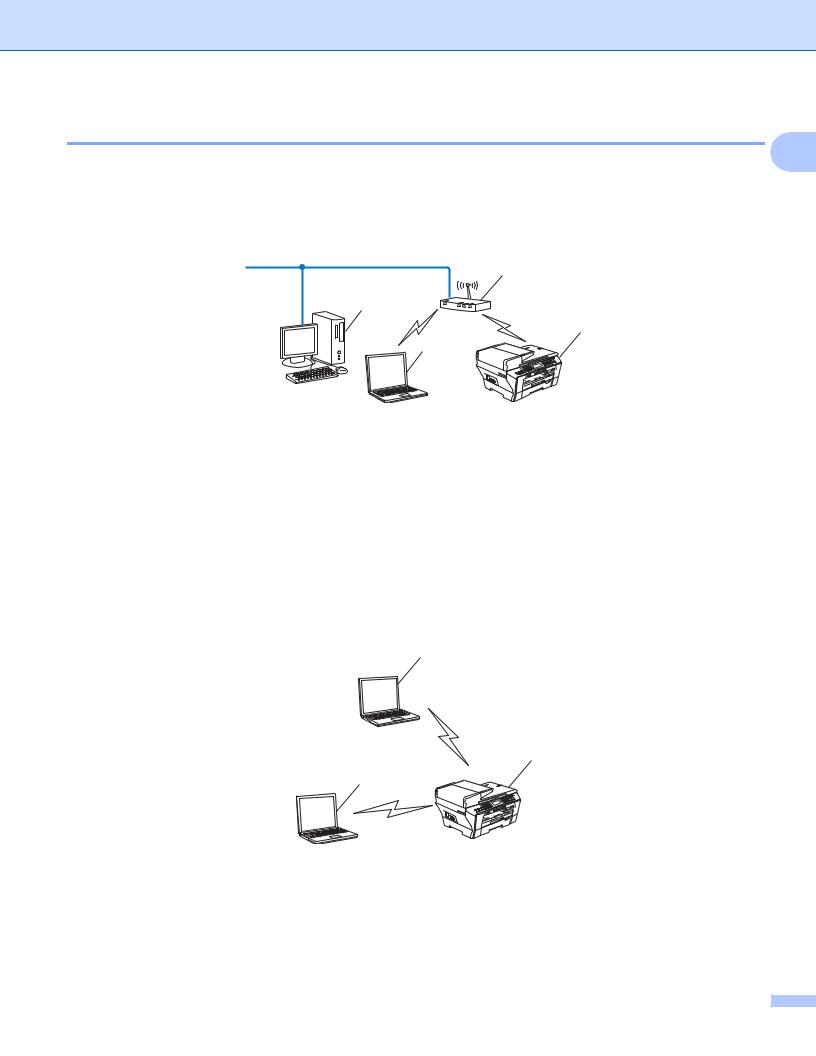
Introduction
Wireless network connection examples
1
Connected to a computer with an access point on the network (Infrastructure mode)
This type of network has a central access point at the heart of the network. The access point can also act as a bridge or a gateway to a wired network. When the Brother wireless machine (your machine) is part of this network, it receives all print jobs via an access point.
1
4
2
3
1Access point
2Wireless network printer (your machine)
3Wireless capable computer communicating with the access point
4Wired computer which is not wireless capable connected to the access point with the Ethernet cable
Connected to a wireless capable computer without an access point on the network (Ad-hoc mode)
This type of network does not have a central access point. Each wireless client communicates directly with each other. When the Brother wireless machine (your machine) is part of this network, it receives all print jobs directly from the computer sending the print data.
2
1
2
1Wireless network printer (your machine)
2Wireless capable computer
6

Introduction
Protocols
1
TCP/IP protocols and functions
Protocols are the standardized sets of rules for transmitting data on a network. Protocols allow users to gain access to network connected resources.
The print server used on this Brother product supports the TCP/IP (Transmission Control Protocol/Internet Protocol) protocols.
TCP/IP is the most popular set of protocols used for communication such as Internet and E-mail. This protocol
can be used in almost all operating systems such as Windows®, Mac OS® X and Linux®. The following TCP/IP protocols are available on this Brother product.
DHCP/BOOTP/RARP
By using the DHCP/BOOTP/RARP protocols, the IP address can be automatically configured.
 Note
Note
To use the DHCP/BOOTP/RARP protocols, please contact your network administrator.
APIPA
If you do not assign an IP address manually (using the control panel of the machine or the BRAdmin software) or automatically (using a DHCP/BOOTP/RARP server), the Automatic Private IP Addressing (APIPA) protocol will automatically assign an IP address from the range 169.254.1.0 to 169.254.254.255.
DNS client
The Brother print server supports the Domain Name System (DNS) client function. This function allows the print server to communicate with other devices by using its DNS name.
LPR/LPD
Commonly used printing protocols on a TCP/IP network.
SMTP client (For MFC-6490CW)
Simple Mail Transfer Protocol (SMTP) client is used to send E-mails via Internet or Intranet.
Port9100
Another commonly used printing protocol on a TCP/IP network.
mDNS
mDNS allows the Brother print server to automatically configure itself to work in a Mac OS® X Simple Network Configured system. (Mac OS® X 10.2.4 or greater)
7

Introduction
TELNET
The Brother print server supports TELNET server for command line configuration. |
1 |
SNMP
The Simple Network Management Protocol (SNMP) is used to manage network devices including computers, routers and Brother network ready machines.
Web Services
The Web Services protocol enables Windows Vista® users to install the Brother printer driver by right-clicking
the machine icon from the Network folder. (See Installation when using Web Services (For Windows Vista® users) on page 152.) The Web Services also let you check the current status of the machine from your computer.
FTP client (For MFC-5890CN and MFC-6490CW)
The File Transfer Protocol (FTP) allows the Brother machine to scan black and white or color documents directly to an FTP server located locally on your network or on the internet.
IPv6 (For MFC-5490CN, MFC-5890CN, MFC-6490CW and DCP-6690CW)
Your brother machine is compatible with IPv6, the next generation internet protocol. For more information on the IPv6 protocol, visit http://solutions.brother.com.
Other Protocol
LLTD
The Link Layer Topology Discovery protocol (LLTD) lets you locate the Brother machine easily on the
Windows Vista® Network Map. Your Brother machine will be shown with a distinctive icon and the node name. The default setting for this protocol is Off.
You can activate LLTD using the BRAdmin Professional utility software. Visit the download page for your model at http://solutions.brother.com to download BRAdmin Professional.
8

|
|
|
|
|
|
2 |
Configuring your machine for a network |
|
|
with an Ethernet cable connection |
|
|
|
||
|
|
|
|
Overview
2
Before using your Brother machine in a network environment, you must install the Brother software and also configure the appropriate TCP/IP network settings on the machine itself. In this chapter, you will learn the basic steps required to print over the network using TCP/IP protocol.
We recommend that you use the Brother installer on the Brother CD-ROM to install the Brother software as this will guide you through the software and network installation. Please follow the instructions in the supplied Quick Setup Guide.
 Note
Note
If you do not wish to, or are unable to use the automatic installer or any of Brother’s software tools, you can also use the machine’s control panel to change network settings. For more information, see Control panel setup on page 77.
IP addresses, subnet masks and gateways
To use the machine in a networked TCP/IP environment, you need to configure its IP address and subnet mask. The IP address you assign to the print server must be on the same logical network as your host computers. If it is not, you must properly configure the subnet mask and the gateway address.
IP address
An IP address is a series of numbers that identifies each device connected to a network. An IP address consists of four numbers separated by dots. Each number is between 0 and 255.
Example: In a small network, you would normally change the final number.
•192.168.1.1
•192.168.1.2
•192.168.1.3
9

Configuring your machine for a network with an Ethernet cable connection
How the IP address is assigned to your print server:
If you have a DHCP/BOOTP/RARP server in your network (typically a UNIX®/Linux®, Windows® 2000/XP or Windows Vista® network) the print server will automatically obtain its IP address from that server.
2
Note
On smaller networks, the DHCP server may be the Router.
For more information on DHCP, BOOTP and RARP, see Using DHCP to configure the IP address
on page 146, Using BOOTP to configure the IP address on page 147 and Using RARP to configure the IP address on page 148.
If you do not have a DHCP/BOOTP/RARP server, the Automatic Private IP Addressing (APIPA) protocol will automatically assign an IP address from the range 169.254.1.0 to 169.254.254.255. For more information on APIPA, see Using APIPA to configure the IP address on page 148.
If the APIPA protocol is disabled, the default IP address of a Brother print server is 192.0.0.192. However, you can easily change this IP address number to match with the IP address details of your network. For information on how to change the IP address, see Setting up the IP address and subnet mask on page 12.
Subnet mask
Subnet masks restrict network communication.
Example: Computer1 can talk to Computer2
•Computer1
IP Address: 192.168.1.2 Subnet Mask: 255.255.255.0
•Computer2
IP Address: 192.168.1.3 Subnet Mask: 255.255.255.0
 Note
Note
0 denotes that there is no limit to communication at this part of the address.
In the above example, we can communicate with any device that has an IP address that begins with
192.168.1.X.
Gateway (and router)
A gateway is a network point that acts as an entrance to another network and sends data transmitted via the network to an exact destination. The router knows where to direct data that arrives at the gateway. If a destination is located at an external network, the router transmits data to the external network. If your network communicates with other networks, you may need to configure the Gateway IP address. If you do not know the Gateway IP address then contact your Network Administrator.
10

Configuring your machine for a network with an Ethernet cable connection
Step by step chart
a Configure the TCP/IP settings.
Configure the IP address |
i |
See page 12 |
2 |
|
|||
Configure the subnet mask |
i |
See page 12 |
|
Configure the gateway |
i |
See page 12 |
|
b Change the print server settings. |
|
|
|
Using the BRAdmin Light utility |
i |
See page 15 |
|
Using the BRAdmin Professional utility |
i |
See page 16 |
|
Using the control panel |
i |
See page 77 |
|
Using the Remote Setup |
i |
See page 17 |
|
Using other methods |
i |
See page 146 |
|
11

Configuring your machine for a network with an Ethernet cable connection
Setting up the IP address and subnet mask
Using the BRAdmin Light utility to configure your machine as a network printer
2
BRAdmin Light
The BRAdmin Light utility is designed for initial setup of the Brother network connected devices. It also can search for Brother products in a TCP/IP environment, view the status and configure basic network settings,
such as IP address. The BRAdmin Light utility is available for Windows® 2000/XP, Windows Vista® and Mac OS® X 10.2.4 or greater.
How to configure your machine using the BRAdmin Light utility
 Note
Note
•Please use the BRAdmin Light utility version that was supplied on the CD-ROM of your Brother product. You can also download the latest Brother BRAdmin Light utility version from http://solutions.brother.com.
•If you require more advanced printer management, use the latest Brother BRAdmin Professional utility that is available as a download from http://solutions.brother.com. This utility is only available for Windows® users.
•If you are using Windows® Firewall or a firewall function of anti-spyware or antivirus applications, temporarily disable them. Once you are sure that you can print, configure the software settings following the instructions again.
•Node Name: Node Name appears in current BRAdmin Light window. The default Node Name of the print server in the machine is “BRNxxxxxxxxxxxx” (“xxxxxxxxxxxx” is your machine’s Ethernet address.).
•For MFC-5490CN, MFC-5890CN, MFC-6490CW and DCP-6690CW, the default password is “access“.
For other models, no password is required by default. To set a password, double-click the device you want to set a password. Click Control tab, and then click Change Password. Enter the new password.
a Start the BRAdmin Light utility.
For Windows® 2000/XP and Windows Vista®
Click Start / All Programs 1 / Brother / BRAdmin Light / BRAdmin Light.
1 Programs for Windows® 2000 users
For Mac OS® X 10.2.4 or greater
Double-click Macintosh HD (Startup Disk) / Library / Printers / Brother / Utilities / BRAdmin Light.jar file.
b BRAdmin Light will search for new devices automatically.
12
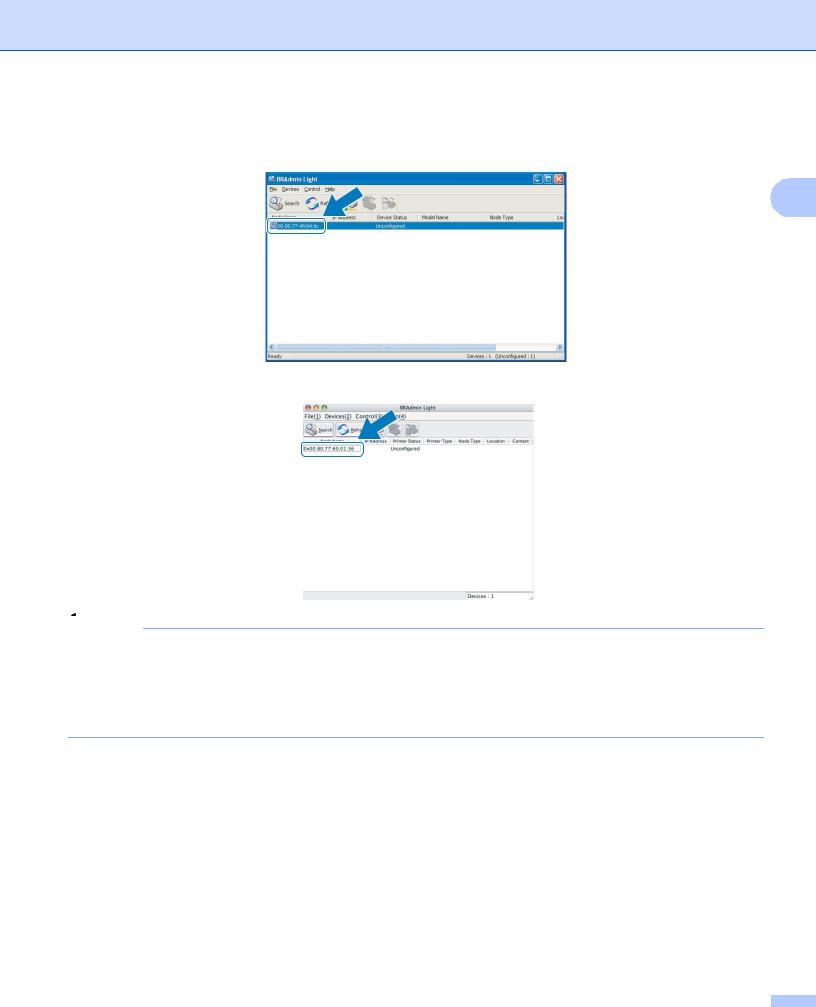
Configuring your machine for a network with an Ethernet cable connection
c Double-click the unconfigured device.
Windows®
2
Macintosh®
 Note
Note
•If the print server is set to its factory default settings (if you don’t use a DHCP/BOOTP/RARP server), the device will appear as Unconfigured in the BRAdmin Light utility screen.
•You can find the Node Name and Ethernet address by printing the Network Configuration List. (See Printing the Network Configuration List on page 113 for information on how to print the Network Configuration List on your print server.)
13
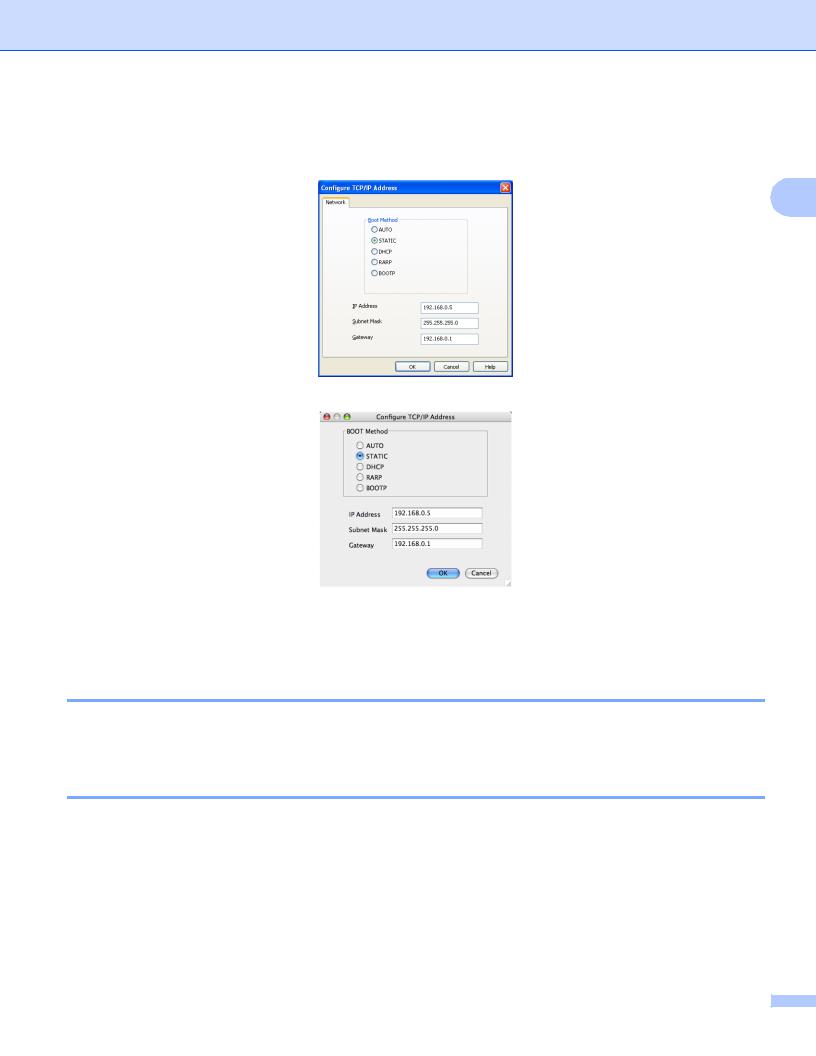
Configuring your machine for a network with an Ethernet cable connection
d Choose STATIC from Boot Method. Enter the IP Address, Subnet Mask and Gateway (if needed) of your print server.
Windows®
2
Macintosh®
e f
Click OK.
With the correctly programmed IP address, you will see the Brother print server in the device list.
Using the control panel to configure your machine for a network
You can configure your machine for a network using the control panel Network menu. (See Control panel setup on page 77.)
Using other methods to configure your machine for a network
You can configure your machine for a network using other methods. (See Other ways to set the IP address (for advanced users and administrators) on page 146.)
14

Configuring your machine for a network with an Ethernet cable connection
Changing the print server settings
 Note
Note
For wireless network users, you need to configure the wireless settings to change the print server settings. 2
(See Configuring your machine for a wireless network (Not available for MFC-5490CN and MFC-5890CN) on page 18.)
Using the BRAdmin Light utility to change the print server settings
a Start the BRAdmin Light utility.
For Windows® 2000/XP and Windows Vista®
Click Start / All Programs 1/ Brother / BRAdmin Light / BRAdmin Light.
1 Programs for Windows® 2000 users
For Mac OS® X 10.2.4 or greater
Double-click Macintosh HD (Startup Disk) / Library / Printers / Brother / Utilities / BRAdmin Light.jar file.
b Choose the print server which you want to change the settings. c Choose Network Configuration from the Control menu.
d Enter a password if you have set one.
e You can now change the print server settings.
 Note
Note
If you want to change more advanced settings, use the BRAdmin Professional utility that is available as a download from http://solutions.brother.com. For Windows® only.
15
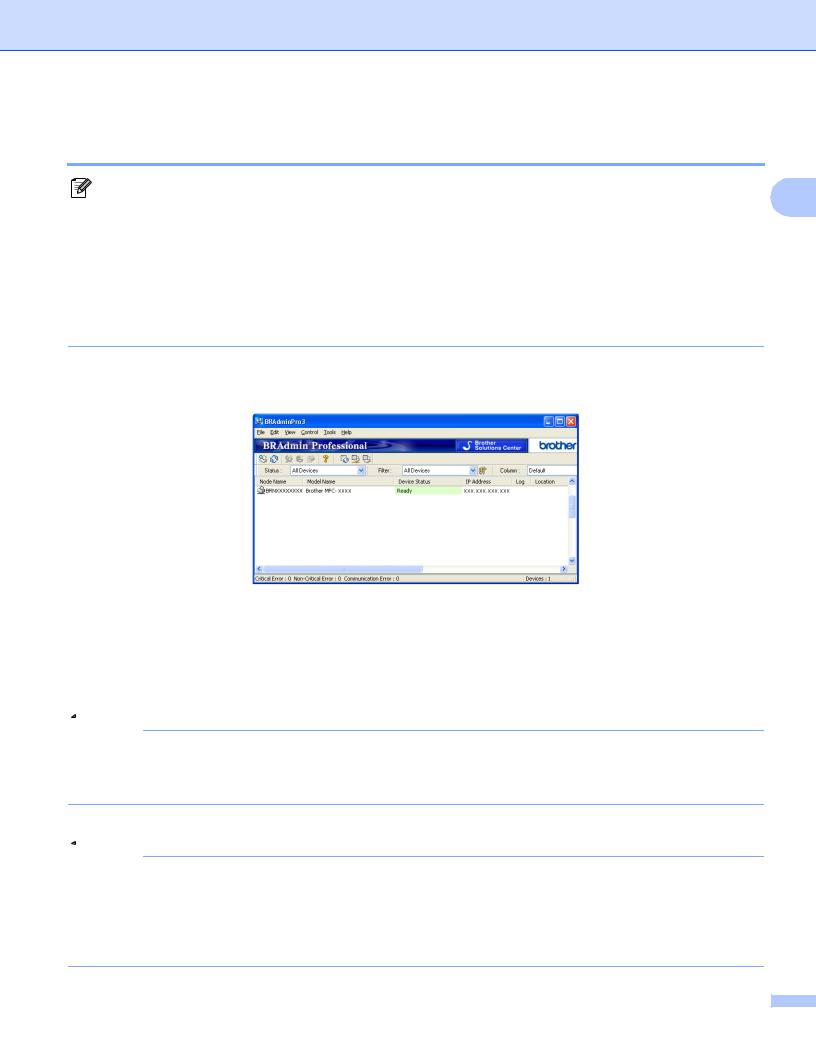
Configuring your machine for a network with an Ethernet cable connection
Using the BRAdmin Professional utility to change the wireless settings (For Windows®)
Note |
|
2 |
|
• Please use the latest version of the BRAdmin Professional utility that is available as a download from http://solutions.brother.com. This utility is only available for Windows® users.
• If you are using Windows® Firewall or a firewall function of anti-spyware or antivirus applications, temporarily disable them. Once you are sure that you can print, configure the software settings following the instructions again.
• Node name: The node name appears in the current BRAdmin Professional window. The default Node name is “BRNxxxxxxxxxxxx” or “BRWxxxxxxxxxxxx” (“xxxxxxxxxxxx” is your Ethernet address.).
a Start the BRAdmin Professional utility (from Windows® 2000/XP or Windows Vista®), by clicking Start /
All Programs 1 / Brother Administrator Utilities / Brother BRAdmin Professional Utilities / BRAdmin Professional3.
1 Programs for Windows® 2000 users
b Choose TCP/IP in the left frame of the main BRAdmin window.
c Choose the print server which you want to configure, in the right frame of the main BRAdmin window. d Choose Configure Wireless Setting from the Control menu.
e Enter a password if you have set one.
 Note
Note
For MFC-5490CN, MFC-5890CN, MFC-6490CW and DCP-6690CW, the default password is “access“.
For other models, no password is required by default. To set a password, double-click the device you want to set a password. Click Control tab, and then click Change Password. Enter the new password.
f You can now change the wireless settings.
 Note
Note
•If the print server is set to its factory default settings without using a DHCP/BOOTP/RARP server, the device will appear as APIPA in the BRAdmin Professional utility screen.
•You can find the node name and Ethernet address (IP Address above) by printing out the Network Configuration List. (See Printing the Network Configuration List on page 113 for information on how to print the Network Configuration List on your print server.)
16

Configuring your machine for a network with an Ethernet cable connection
Using the Remote Setup to change the print server settings (Not available for DCP models)
Remote Setup for Windows® |
2 |
The Remote Setup application allows you to configure network settings from a Windows® application. When you access this application, the settings on your machine will be downloaded automatically to your PC and displayed on your PC screen. If you change the settings, you can upload them directly to the machine.
a Click the Start button, All Programs 1, Brother, MFC-XXXX LAN, then Remote Setup (where XXXX is your model name).
1 Programs for Windows® 2000 users
b Enter a password if you have set one.
 Note
Note
For MFC-5490CN, MFC-5890CN, MFC-6490CW and DCP-6690CW, the default password is “access“. For other models, no password is required by default.
c d
Click TCP/IP (Wired) or Setup Misc.
You can now change the print server settings.
Remote Setup for Macintosh®
The Remote Setup application allows you to configure many MFC settings from a Macintosh® application. When you access this application, the settings on your machine will be downloaded automatically to your
Macintosh® and displayed on your Macintosh® screen. If you change the settings, you can upload them directly to the machine.
a Double-click the Macintosh HD icon on your desktop, Library, Printers, Brother, then Utilities. b Double-click the Remote Setup icon.
c Enter a password if you have set one.
 Note
Note
For MFC-5490CN, MFC-5890CN, MFC-6490CW and DCP-6690CW, the default password is “access“. For other models, no password is required by default.
d e
Click TCP/IP (Wired) or Setup Misc.
You can now change the print server settings.
Using the control panel to change the print server settings
You can configure and change the print server settings using the control panel Network menu. (See Control panel setup on page 77.)
17

Configuring your machine for a wireless 3 network (Not available for MFC-5490CN
and MFC-5890CN)
Overview
To connect your machine to your wireless network, you need to follow the steps in the Quick Setup Guide. |
3 |
We recommend that you use the Setup Wizard from the machine’s control panel Network menu. By using |
|
this method, you can easily connect your machine to your wireless network. Please follow the instructions in the supplied Quick Setup Guide.
Please read this chapter for more details on how to configure the wireless network settings. For information on TCP/IP settings, see Setting up the IP address and subnet mask on page 12. Then, in Network printing
from Windows® basic TCP/IP Peer-to-Peer printing on page 119 and Network printing from a Macintosh® on page 122, you will learn how to install the network software and drivers into the operating system running on your computer.
 Note
Note
•To achieve optimum results with normal every day document printing, place the Brother machine as close to the network access point (or router) as possible with minimal obstructions. Large objects and walls between the two devices as well as interference from other electronic devices can affect the data transfer speed of your documents.
Due to these factors, wireless may not be the best method of connection for all types of documents and applications. If you are printing large files, such as multi-page documents with mixed text and large graphics, you may want to consider choosing wired Ethernet for a faster data transfer, or USB for the fastest throughput speed.
•Although the Brother machine can be used in both a wired and wireless network, only one connection method can be used at a time.
18

Configuring your machine for a wireless network (Not available for MFC-5490CN and MFC-5890CN)
Wireless network terms and concepts
If you want to use your machine in a wireless network you must configure the machine to match the settings of the existing wireless network. This section provides some of the main terms and concepts of these settings, which may be helpful when you configure your machine for a wireless network.
SSID (Service Set Identifier) and channels |
3 |
You need to configure the SSID and a channel to specify the wireless network you want to connect to.
SSID
Each wireless network has its own unique network name and it is technically referred to as SSID or ESSID (Extended Service Set Identifier). The SSID is a 32-byte or less value and is assigned to the access point. The wireless network devices you want to associate to the wireless network should match the access point. The access point and wireless network devices regularly send wireless packets (referred to as a beacon) which has the SSID information. When your wireless network device receives a beacon, you can identify the wireless network that is close enough for the radio waves to reach your device.
Channels
Wireless networks use channels. Each wireless channel is on a different frequency. There are up to 14 different channels that can be used when using a wireless network. However, in many countries the number of channels available are restricted. For further information, see Ethernet wireless network on page 154.
Authentication and encryption
Most wireless networks use some kind of security settings. These security settings define the authentication (how the device identifies itself to the network) and encryption (how the data is encrypted as it is sent on the network). If you do not correctly specify these options when you are configuring your Brother wireless device, it will not be able to connect to the wireless network. Therefore care must be taken when configuring these options. Please refer to the information below to see which authentication and encryption methods your Brother wireless device supports.
Authentication methods
The Brother machine supports the following methods:
Open System
Wireless devices are allowed to access the network without any authentication.
Shared Key
A secret pre-determined key is shared by all devices that will access the wireless network. The Brother wireless machine uses the WEP keys as the pre-determined key.
WPA-PSK/WPA2-PSK
Enables a Wi-Fi® Protected Access Pre-shared key (WPA-PSK/WPA2-PSK), which enables the Brother wireless machine to associate with access points using TKIP for WPA-PSK or AES for WPA-PSK and WPA2-PSK (WPA-Personal).
19

Configuring your machine for a wireless network (Not available for MFC-5490CN and MFC-5890CN)
Encryption methods
Encryption is used to secure the data that is sent over the wireless network. The Brother wireless machine supports the following encryption methods:
None
No encryption method is used.
WEP |
3 |
By using WEP (Wired Equivalent Privacy), the data is transmitted and received with a secure key.
TKIP
TKIP (Temporal Key Integrity Protocol) provides per-packet key mixing a message integrity check and re-keying mechanism.
AES
AES (Advanced Encryption Standard) is the Wi-Fi® authorized strong encryption standard.
Network Key
There are some rules for each security method:
Open System/Shared Key with WEP
This key is a 64-bit or 128-bit value that must be entered in an ASCII or hexadecimal format.
•64 (40) bit ASCII:
Uses 5 text characters e.g. “WSLAN” (this is case sensitive).
•64 (40) bit hexadecimal:
Uses 10 digits of hexadecimal data e.g. “71f2234aba”.
•128 (104) bit ASCII:
Uses 13 text characters e.g. “Wirelesscomms” (this is case sensitive).
•128 (104) bit hexadecimal:
Uses 26 digits of hexadecimal data e.g. “71f2234ab56cd709e5412aa2ba”.
WPA-PSK/WPA2-PSK and TKIP or AES
Uses a Pre-Shared Key (PSK) that is 8 or more characters in length, up to a maximum of 63 characters.
20
